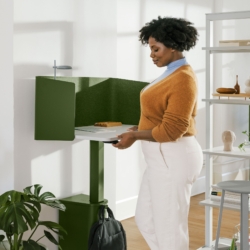August 8, 2024
How do you encourage people to spend more time in the office? Here are seven things to consider
In a world in which people have more choice about how and where to work, how do you encourage people to spend more time in the office without issuing controversial mandates? Some of the UK’s most high-profile workplace, design, property and facilities management experts met recently at the London showroom of MillerKnoll to discuss the answers to this, one of the most vexed questions of recent years. How do you create workplaces that meet the needs of people who have more choices than ever of how, when and where to work? And its corollary: if you want people to spend more time in the office with each other, how do you entice them to do so without making it an obligation?
The touchstone for the conversation was a paper from Dr Nigel Oseland and Dr Gary Raw. It explores the factors that drive people’s preferences, what they mean for workplace strategists and how organisations can offer a working culture and choices that allow people to tailor the way they work while also meeting the wider needs of the organisation.
The research provides valuable insights into the preferences and influences of employees when it comes to working from home or in the office. It is clear from the study that there is no one-size-fits-all approach, and organisations need to consider the specific needs and preferences of individuals. By creating office spaces that support concentration, privacy, teamwork, and a sense of purpose, organisations can attract employees back to the office while also providing the flexibility and personal benefits that come with remote work.
You can see the full paper here. Or our special supplement based on the round table here.
Seven key takeaways from the report
There are eight factors that underpin workplace strategy
The report identifies eight main factors that shape workplace strategy: organisational belonging, work interactions, health and wellbeing, concentration, workstation control, environmental control, workload management, and personal time management. These offer a simplification of 51 other factors into more manageable categories, helping organisations focus on core areas to improve employee satisfaction and productivity.
Use these things to attract people back to the office
The main attractors for employees to work in the office include interactions with colleagues (teamwork, socialising, and connection), a clear delineation between work and home life, avoiding loneliness (highlighted as an increasing health issue in the UK), engaging with organisational culture, maintaining a consistent daily routine, and accessing quality work space (ergonomics and technology). These factors are essential for creating an environment that supports both professional and personal needs.
So, key elements to attract employees back to the office include collegiate and social elements (rated highly by respondents), stimulation and creativity (enhanced by face-to-face interactions), variety and encounters (through a variety of office spaces), learning and mentoring (more effective in-person), and a variety of quality settings (e.g., quiet areas, collaborative spaces). The report emphasises that a multifaceted approach is required to make the office a more attractive option when compared to home.
Address personal preferences and circumstances
Organisational influences such as a sense of belonging and connection with work culture, alongside personal factors like routine and workstation quality, significantly affect preferences for working in the office compared to working at home.
The report stresses the importance of considering these individual preferences and personal circumstances in developing workplace strategy. For instance, those with a dedicated home office rated their environment highly for ergonomics and productivity, whereas those working at, for example, kitchen tables preferred the office. New recruits and those with less than one year of remote work experience showed a stronger preference for office work, highlighting the need for mentoring and integration.
The survey revealed that introverts generally prefer working from home due to fewer distractions and more control over their work environment, while extroverts and ambiverts show a less pronounced difference between home and office preferences. Extroverts find the office better for creativity, teamwork, meetings, and leadership experiences
Create a sense of purpose and belonging
A strong sense of purpose and belonging is crucial for attracting employees back to the office. The majority of respondents believe the office better supports connection and reward, particularly through leadership and motivation, aligning with company culture, and reducing the fear of missing out (FOMO). As a result, regular events, social occasions, clubs and wellness facilities can enhance this sense of purpose and belonging.
Assess the environmental impact of decisions
Reduced environmental impact is one of the factors people think favours working from home. But companies should analyse the true environmental impact of splits between in-office and remote work, as this should influence future workplace strategies to help them meet net zero targets and improve sustainability. A number of factors should be considered and not just reduced fuel consumption for those who commute by car.
Organisations need better technology
There is a significant need for improved office technology to support a frictionless workplace experience for people who are increasingly likely to work in more flexible ways. Enhancing office technology is crucial to attract employees back to the office, as technological shortcomings were highlighted as a deterrent for preferring the office over home, but also better meet the needs of a dispersed, agile workforce.
Get in touch with the feelings of people
The sentiment analysis of workplace comments identified three key perspectives: attracting people back to the office, the real concerns of employees, and the different advantages of office and home environments. This analysis highlighted the complex feelings people have towards their work environments, providing deeper insights into how organisations can address these issues effectively.















